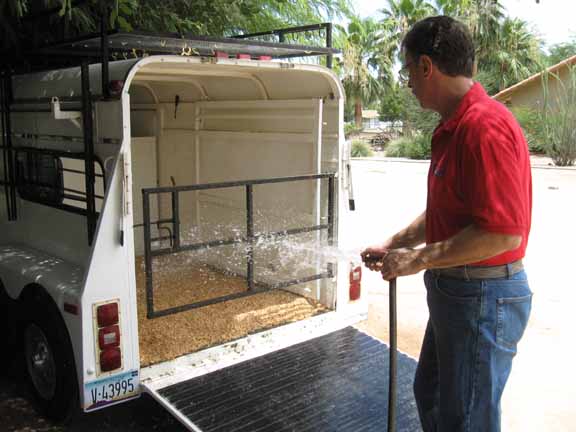|
I had a phone call tonight from a lady
wondering if Miniature Horses are as hardy as the big horses. In
many ways they are, but it is important to know that babies can over
heat, dehydrate and die. The babies can fall asleep in the sun, not
realizing they are hot and overheat. After about 8 weeks, they wake
up more easily and realize to move into the shade, but we watch them
very closely when they are young.
Also, here in Arizona, it is not
unusual for a June day to get over 105 degrees. Obviously, shade is
a must. One mistake many mini owners make it to build a short barn.
The heat is held in down closer to the minis. Even though, they are
small, it is still a good idea to build your shades up high.
We do feed a homemade electrolyte
daily during the summer heat to keep them all drinking. Even though
our stalls have automatic waterers, I also keep a bucket of clean
water available.
|
|
| Many of us install fans in our barn.
These not only help with temperatures, but are a huge help during
fly and mosquito season. The horses learn quickly to stand directly
in the line of airflow. Then, there are misters. We have not
found them necessary, but they are a good way to drop the
temperature 10-20 degrees! We do have them in our barn for our
horses.
And, if you are going to
travel in the heat, bed your trailer deeply with shavings,
then soak them just before you take off. Remember that your
mini's hooves are traveling just above the pavement and that
the black top is hotter than ever! Recently we traveled to a
nursing home and even took water in containers to soak the
shavings as we traveled.
Click here to see this trip.
Also when traveling, take
water from home. Many horses learn what "their" water from
home tastes like and reject other water. We take our own
water to eliminate this.
Need shade on your miniature
horse cart? Here is an idea... |
 |
After a heat related death of a horse
at a show, this equation was given for measuring if it is too hot to
work your horse. I have never used this as a monitor, but it is
interesting to play with in your head... Add air temperature and
relative humidity and subtract wind speed. If your total is 180 or
higher, don't ride. If it is 130-170, use caution. If it is 130 or
below, they say you can ride.
Here was their rating and rationale
for caution when the total is above 130:
Less than 130: All go—horses can function to cool themselves
assuming adequate hydration.
130 – 170: Caution—a horse's cooling mechanisms can only partially
function as intended. Some cooling management procedures will need
to be performed.
180 or above: Stop—a horse's cooling systems cannot and will not
function adequately. All cooling procedures will need to be utilized
to keep the horse out of serious trouble.
Why is it an issue for the horse when heat and humidity combine to
equal 180+? What doesn't work and why? What are some of the
physiological ramifications? What are some of the symptoms? Heat is
produced by muscles in the metabolic conversion of chemical energy
to the mechanical energy required for muscle contraction and limb
movement. Seventy-five to eighty percent of the chemical energy is
converted to heat, which moves from the contracting skeletal
muscles to the surrounding tissues by the flow of lymph and blood.
Assuming a comparable rate of exercise intensity, the rate of
cooling, or heat loss is affected by air temperature, wind velocity
and humidity. (Werner, 1993). Heat can also be lost in a fourth way,
conduction, which is a direct transfer of heat from the skin or feet
to surfaces in direct contact (such as an ice bag on the skin).
So, thinking about the chart and the equation:
Temperature (F) + relative humidity (%) – wind speed (MPH), we see
how the ability of the horse to cool itself in these four different
ways will be affected:
• In cool temps with low humidity, heat loss through convection and
conduction can be as much as 50%. Heat can also be lost through
radiation, with as much as 60% of a body's heat lost in this way
when air temperatures are cool. The numbers in our equation would
add up to much less than 180, and the horse would have no difficulty
cooling itself.
• As temperatures rise, the thermal gradient for heat dissipation is
reduced, resulting is less convective, conductive and radiative heat
loss and more evaporative cooling. The evaporation of water from the
skin surface is the most important means of heat dissipation in
high-heat/low-humidity conditions. So, when we get a high
temperature reading with low humidity, a horse may still not have
difficulty cooling, but if temperatures are extremely high with no
wind, we might get a result above 140, which would means our horse
needs our help cooling off.
• With high humidity, sweat cannot evaporate as easily and so the
ability of the horse to cool itself in this important way is
reduced. When high humidity is combined with high temperatures,
(which we just saw reduce the effectiveness of radiant, conductive
and convective cooling), the horse has now lost all four means to
cool itself and is in a dangerous situation, subject to a greater
rate of heat accumulation within his body.
This was on one of the yahoo groups.
I can't vouch for the validity of the formula, but it's an
interesting thought process to consider.



